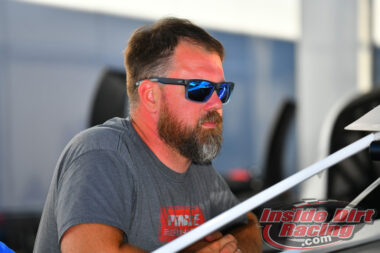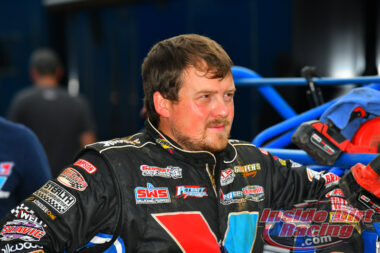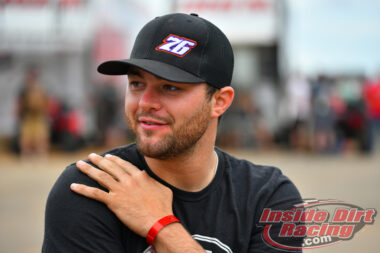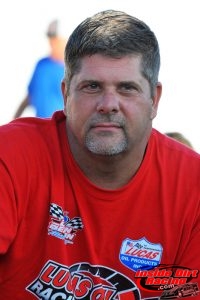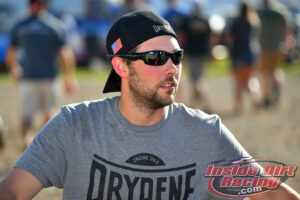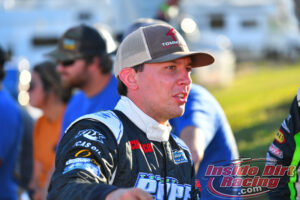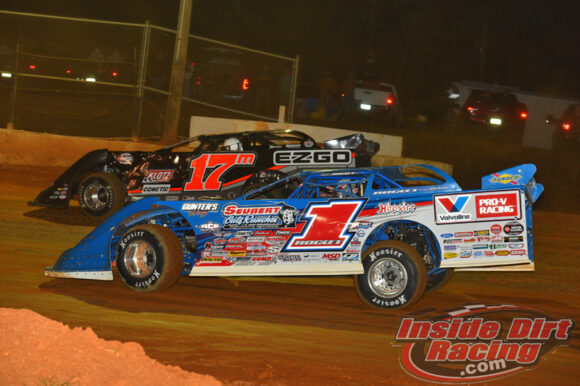
Drivers like Brandon Sheppard(1) and Dale McDowell share their thoughts on aggression during heat races
From the perspective of someone who has never driven a race car, it seems that the moment that sets the tone for a driver’s success or failure on any given night is the first lap of his/her heat race. A well executed first lap can all but assure a good starting position for the feature. On the other hand, a bungled first lap can send the driver to a B-main which will lead to a poor starting position in the main event or even failure to make the show.
When asked about the importance of getting off to a good start in the heat races, there was widespread agreement on that necessity. Many racers mentioned to impact of aerodynamics on modern-day race cars or the need to qualify well as part of the full heat race equation.
For this piece, drivers were asked two questions. As a result, their comments are broken into two parts in order to provide clarity for each answer.
Here are the two questions asked of each driver:
It seems like the most aggressive part of the race night comes on lap one of the heat races. Do you agree with that and how do you gauge just how aggressive you need to be?
At the same time, you can ruin your whole night on lap one of the heat race by being too aggressive. How do you make sure that doesn’t happen?
Here are the answers given by each driver:
Jonathan Davenport: “I agree with that to a certain extent. I would say your first lap in qualifying is your most aggressive lap, but as in competition with other cars, because the heat races are really short and generally the race tracks are making that transition to where they’re just about one lane at that point. You’ve got to be very aggressive, but cautious, because that’s when most people make their mistakes. You can mess up the worst or you can capitalize the most.”
“It’s kind of like a gamble that you have to be willing to take sometimes to try a different line on that first lap or something out of the ordinary. Like I said, it’s an assessment of risk and you try to make up as many spots as you can when you’re starting further back in the heat race.”
Brandon Sheppard: “The key to the whole thing is qualifying. You’ve got to qualify good so you can start on the front row of the heat. You’ve got to finish in the top-2 of that heat race to get a decent starting spot, preferably winning the heat. The way these bigger tracks race, if you don’t start up front, it’s hard to come up through there. If your car is really good and everything plays out right, you can come up through there but it makes your life a lot easier when you run good in the heat race.”
“If you’re over aggressive, like starting on the outside of the front row is a good place to do it from, you run into turn one and the guy on the pole slides you and you lose air and jump the cushion and lose a few spots. Them guys in third and fourth are just waiting for you to mess up and sneak by you and get in the transfer spots. There’s definitely a fine line there with how aggressive you need to be, but the heat races are definitely a key.”
Brandon Overton: “100%. The heat races, the first corner of the first lap, is pretty big because if you’re on the outside pole and beat them to the corner and you win your heat, it moves you up. It’s very important. There ain’t a car in these pits that can’t go somewhere and win. It’s hard to have your car good enough to just go out there and pass people. I think they added it up and you’ve got to have your car three-tenths better than the guy in front of you to just go up and full out pass them and it’s hard to be three-tenths better than anybody these days. Track position means more now than it ever did. For instance, when I drove Weaver’s car, we never did qualify that good but we always raced really good and passed a lot of cars. But them days are over. If you ain’t on the front row of a heat and winning heats to get yourself in the first couple of rows in the feature, it’s hard to win now. Sheppard is a prime example. They’re fast everywhere they go but if you can keep him back there in the heats, he don’t win as much and that goes for anybody. If you put him up there in the front it’s going to be hard to drive by him. You try to take care of your stuff and not wreck each other but you’ve still got to get it done in those heats.”
“You can run yourself out of it too. You’ve just got to know who you’re racing with and pretty much know who you’re starting beside and how they race to judge that first corner. We all make mistakes. Ain’t nobody going to be perfect so you’ve just got to use your best judgement and hope for the best.”
Dale McDowell: “Obviously, I think you’re right in viewing it that way because that determines your starting position for the feature. Now the competition level is just so tight that it’s very important to start close to the front. The other aggressive time of the night is late in the feature when there’s double-file restarts. But really, the heats are so crucial because you don’t have to have the fastest car so to speak. It can just be as simple as starting in the correct line whether it be inside or outside or whatever may go your way. There are a lot of ingredients that go into winning races these days and definitely that early part of the night with qualifying and heats are important.”
“You have to be aggressively under control, if there is such a thing. As drivers sometimes we can back up a little bit and not get 100% out of the car and still be better because we make less mistakes. At the start of the heats you’re closer to getting 100%, but you’re also closer to making a mistake. But it’s the nature of the beast and starting positions are very important.”
Earl Pearson Jr.: “This day and time it is all about the heat racing. The qualifying is critical but the first lap of the heat race is very, very critical. You’ve got to be aggressive because it’s only ten laps long and you’ve got to get all you can get in the first corner. Everybody here has got good equipment, good motors, good talent, and you’ve only got ten laps to get it done so you’ve got to go all out on the first lap. I mean that’s the only thing you can do.”
“There ain’t no doubt. You get in there too hot and get into somebody or bust a tire or jump the cushion then it’s not good after that, for sure. The biggest thing is that if you’re going to do a power move, you better make sure you do it right otherwise you’ll be in serious trouble.”
Ricky Weiss: “Your qualifying lap is so important because if you qualify mid-pack there is still a chance that you can make it up in the first lap going in the heat race. But in the same sense, you don’t want to be the guy who is going to lean on someone and maybe cut down a tire or something. You also don’t want to hang back because once the cars spread out, you’re not really going to pass them. I’d say that first lap of the heat can determine 80% of your night, for sure.”
“You go up the track and go to the back of the heat or spin yourself out or you wreck the car and don’t finish, that’s the 20% you’ve got to hold back and try to be smart about it.”
Devin Moran: “Obviously, qualifying sets the tone for that but your heat race really does set up the rest of your night. Lap one of that heat race puts you where you’re going to be. If you have a really good first lap and you’re out front then you know you’re going to be up front in the feature. Most of the time, you can stay up front with the way these cars are these days, especially on the bigger tracks. When that air gets messed up it’s hard to gain time or pass someone when you do get to them. Them heat races are definitely important.”
“Yeah, look at Chris Ferguson at Eldora. He messed up on lap one of his heat race and had to take a provisional. He was good, obviously, he ran in the top-5. But things can go from really good to really bad in a matter of seconds. You’ve got to make sure you’re on your toes and don’t mess up there.”
Respond to this post on Twitter by following @RichardAllenIDR and @MichaelRMoats or by liking the InsideDirtRacing.com Facebook page.
Also, NASCAR and pavement racing fans can check out InsideCircleTrack




